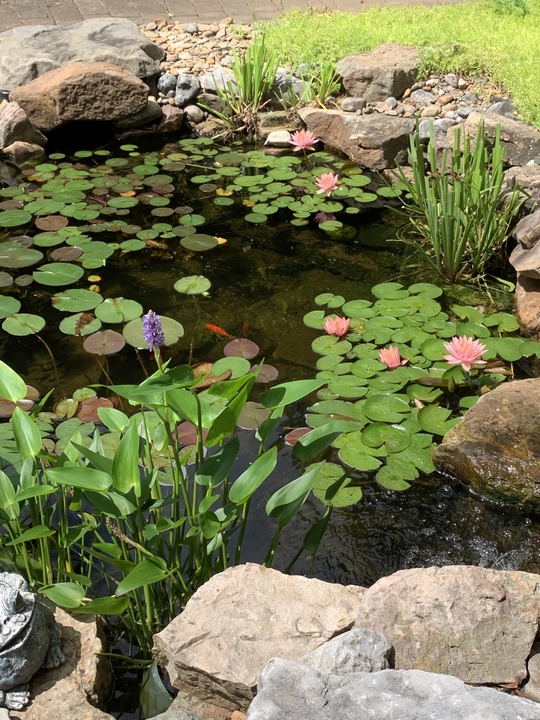Water Features in the Landscape
go.ncsu.edu/readext?876431
en Español / em Português
El inglés es el idioma de control de esta página. En la medida en que haya algún conflicto entre la traducción al inglés y la traducción, el inglés prevalece.
Al hacer clic en el enlace de traducción se activa un servicio de traducción gratuito para convertir la página al español. Al igual que con cualquier traducción por Internet, la conversión no es sensible al contexto y puede que no traduzca el texto en su significado original. NC State Extension no garantiza la exactitud del texto traducido. Por favor, tenga en cuenta que algunas aplicaciones y/o servicios pueden no funcionar como se espera cuando se traducen.
Português
Inglês é o idioma de controle desta página. Na medida que haja algum conflito entre o texto original em Inglês e a tradução, o Inglês prevalece.
Ao clicar no link de tradução, um serviço gratuito de tradução será ativado para converter a página para o Português. Como em qualquer tradução pela internet, a conversão não é sensivel ao contexto e pode não ocorrer a tradução para o significado orginal. O serviço de Extensão da Carolina do Norte (NC State Extension) não garante a exatidão do texto traduzido. Por favor, observe que algumas funções ou serviços podem não funcionar como esperado após a tradução.
English
English is the controlling language of this page. To the extent there is any conflict between the English text and the translation, English controls.
Clicking on the translation link activates a free translation service to convert the page to Spanish. As with any Internet translation, the conversion is not context-sensitive and may not translate the text to its original meaning. NC State Extension does not guarantee the accuracy of the translated text. Please note that some applications and/or services may not function as expected when translated.
Collapse ▲This article was written by Gail Griffin, Extension Master Gardener Volunteer with North Carolina Cooperative Extension in Lee County.
From early July to around mid-August, our summer reaches its peak with scorching heat and high humidity. During that period, there is a 40 day stretch of hot, sultry days commonly referred to as the “dog days of summer”. The reference has nothing to do with dogs, but with the constellation Canis Major, (The Greater Dog) named by ancient Greeks because of its resemblance to the outline of a dog. One of its stars, Sirius, the brightest in the sky, was so brilliant they believed that Earth must receive heat from it. During summer, Sirius rises and sets with the sun. As their alignment occurs in mid-July, the ancients reasoned that the bright light contributed to the stagnant heat in late summer. Thus, the twenty days prior to and the twenty days following this event became known as the dog days. By the 1500’s, the English world adapted the same period of time on their astronomical calendar. Now we know that the earth’s tilt is responsible for the longer, hotter days in the Northern Hemisphere. But here in central North Carolina, we still refer to them as the dog days and we are in their midst.
So, what can we do amid these sweltering temperatures? Well, you could frequent your favorite swimming hole, but if you can’t go every day, this may be a great time to consider adding a backyard water feature. Water can provide a cooling effect, and add movement and texture to areas in the landscape. Features include ponds, waterfalls, fountains or a simple birdbath. Ponds can be treated as their own self-contained ecosystem, meaning they can survive with no input except light. They can range from a small, simple pool to a large Koi pond with boulders or something in between. They can have a natural appearance with plants or a more formal look with stone or brick surrounds. A small bubbler or aerator can provide movement and circulation. Ponds usually require more maintenance than other features to retain water quality.
Pondless features are a great choice if safety is a concern. These include waterfalls or streambeds that cascade into a concealed reservoir. There are no open areas,  but you can still experience the relaxing sound of running water. They can help muffle the noise of a busy street. If a downhill slope is a problem area, it could be an ideal location for a stream or waterfall. The addition of rocks and varieties of plants can give the design a natural look. More complex gardens may require significant planning and maintenance.
but you can still experience the relaxing sound of running water. They can help muffle the noise of a busy street. If a downhill slope is a problem area, it could be an ideal location for a stream or waterfall. The addition of rocks and varieties of plants can give the design a natural look. More complex gardens may require significant planning and maintenance.
Fountains are probably the most economical choice in water features. Water collects in a basin where a pump recirculates it back through the system. They can be as simple or as elaborate as you would like. Almost any vessel that is water tight can be turned into a fountain. You can get creative with different types of containers and the use of repurposed materials. There are many ready made fountains available, most are simple to install and easy to maintain.
Water features help soften the hard lines of architectural elements such as retaining walls and around landscape beds and lawns. They can be used as a focal point, as a way to incorporate art, or as a complementary piece to the rest of your landscape. Accessorizing them with plants will enhance any backyard design. Consider locating these features near an outdoor sitting area where they can show a reflection of the light and the evaporation of the water can help to cool the air. A little shade in a cool spot with the soothing sound of water, doesn’t that sound like a good place to be, especially on the dog days of summer?
Gail Griffin is an Extension Master Gardener Volunteer with North Carolina Cooperative Extension in Lee County.




